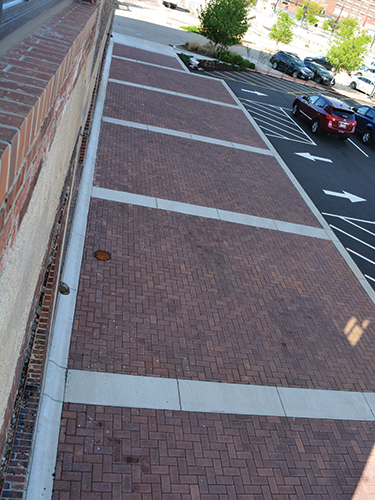Green techniques reduce the damaging impact of stormwater runoff, while enhancing the built environment.
Federal, state and local governments are all focusing efforts on reducing the destructive impacts of stormwater runoff, including pollutant delivery to surface waters, flooding and erosion. In Illinois, we see evidence of stormwater runoff after rainfall events in our yards, streets, fields, streams and rivers. In many communities, green infrastructure is being proposed to provide relief not only to stormwater runoff, but also to combined sewer overflow issues, which several of our local communities are working to resolve.
Local CSO Conditions
In the communities of Peoria, Pekin and Havana, which are served (or partially served) by combined sewers, the negative impacts of stormwater runoff are even more significant. Combined sewers carry both stormwater and sanitary sewage in the same pipe. With minimal rain events, the stormwater is transported within the sewer pipe to the wastewater treatment plant for proper treatment and discharge to the Illinois River. But during periods of heavy rainfall, the combined sewer system and treatment plants are not able to handle the stormwater runoff, resulting in a combined sewer overflow (CSO) to the Illinois River. These discharges contain water with pollutant levels that violate the Clean Water Act.
The Illinois Environmental Protection Agency (IEPA) has been focusing attention on all combined sewer systems within the state since the 1970s. Numerous communities have developed solutions to meet then-current regulations, but with time there have been ever more stringent regulations aimed at reducing pollutant discharges into the receiving streams. The costs of these solutions are very high, with Peoria alone estimating a cost of up to $250 million to meet current CSO regulations.
The IEPA requires each combined sewer community to prepare a Long Term Control Plan (LTCP) defining proposed projects and schedules to meet the regulations. Pekin and Havana have submitted and received IEPA approval of their LTCPs, and have completed many of the projects defined in their plans for compliance. The City of Peoria has submitted its LTCP and is in negotiations with the agency to reach approval.
Reducing Overflows in Pekin and Havana
The City of Pekin’s LTCP proposes additional treatment capacity at its primary wastewater treatment facility, expansion of its stormwater holding facilities, and increased interceptor sewer capacity, as well as other system modifications to reduce the number of combined sewer overflows into the Illinois River. The City also requires stormwater retention and detention—a type of green infrastructure—in new developments to reduce the runoff entering storm sewers and the combined sewer system and provide for infiltration.
These improvements were approved by the IEPA and considered the most cost-effective approach for the City of Pekin. Much of this work is complete, with remaining work limited to storage and interceptor sewer improvements. The total cost of Pekin’s improvements is estimated to be in the range of $50 to $60 million.
Each community’s combined sewer system is unique, and Havana took a different approach to meeting the regulations. While it also requires stormwater retention/detention for new developments within the City, Havana chose sewer separation, combined with better utilization of storage within existing interceptor sewers, at a cost of under $2 million. The City has completed the improvements and is currently analyzing overflow data to determine if the combined sewer system complies with regulations.
Green Infrastructure in the City of Peoria
The City of Peoria’s combined sewer system experiences an average of 20 to 30 overflow events each year. The downtown and bluff areas in the older parts of the city are served by combined sewers. Because sewer separation in these areas would be cost-prohibitive, the City has proposed green infrastructure improvements as the most cost-effective solution to the CSO issue.
Numerous studies have been done across the country assessing the effectiveness of green infrastructure projects. The U.S. Environmental Protection Agency claims managing wet weather impacts are accomplished in a cost-effective method utilizing green infrastructure. When included in site design, green infrastructure reduces and treats stormwater runoff at its source, while at the same time delivering environmental, social and economic benefits. There are various types of green infrastructure projects, including many that have already been constructed within Peoria.
One example of effective green infrastructure is the planter boxes in the Warehouse District, which can collect and absorb runoff from the street, sidewalk and parking areas while enhancing the appearance of the area. The permeable interlocking pavers along the parking lot of the Murray Building are another example of effective green infrastructure. Besides adding to the appearance of the site, they collect runoff from the parking lot and allow it to absorb into the underlying soil.
Bioswales are vegetated channels that provide stormwater treatment and retention. Bioswales were included in the site designs for the Glen Oak Community Learning Center, Peoria Public Library North Branch and Northminster Presbyterian Church, among other recent developments. These channels slow the flow of runoff, allow the vegetation to filter the water, and provide time for water infiltration into the soil or to more slowly enter into the existing storm sewer system.
Green techniques not only reduce the damaging impact of stormwater runoff, they also enhance our built environment by providing aesthetic benefit, habitat, educational opportunities and many other benefits not always associated with buried pipe solutions. Based on the effectiveness of green infrastructure projects at reducing the impact of stormwater runoff, we are likely to see more of them in the future. iBi


